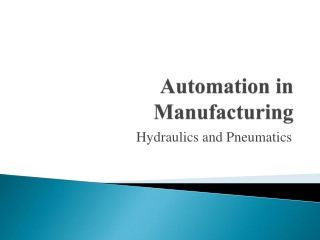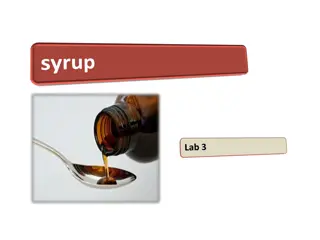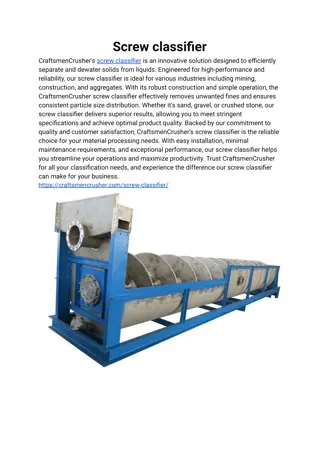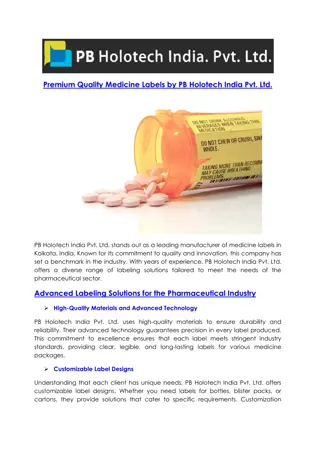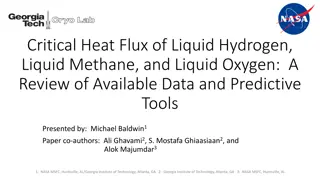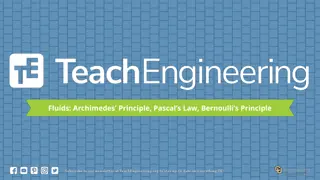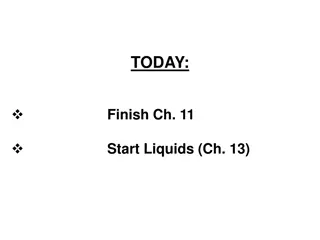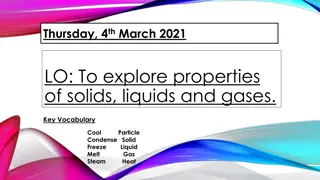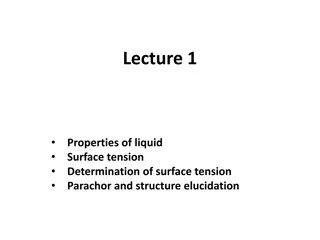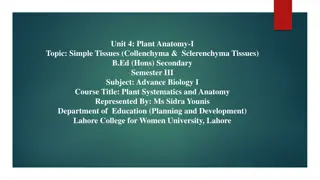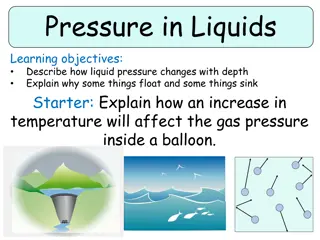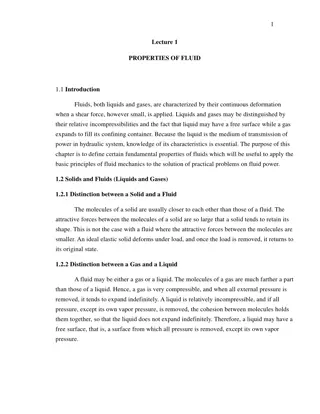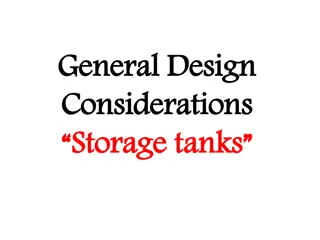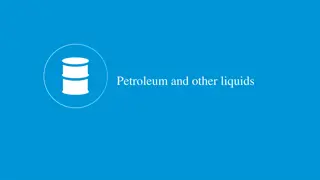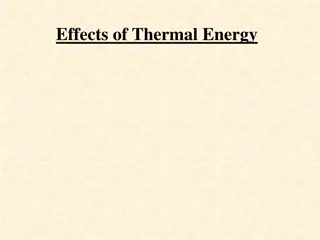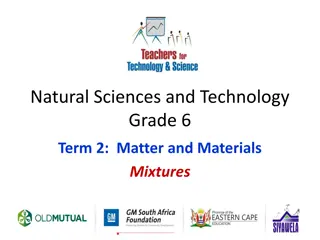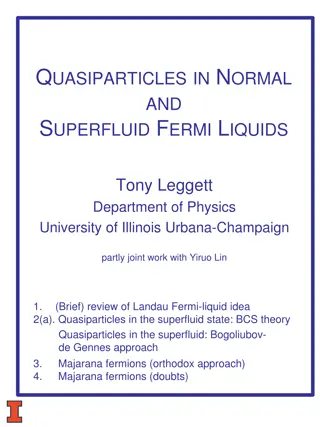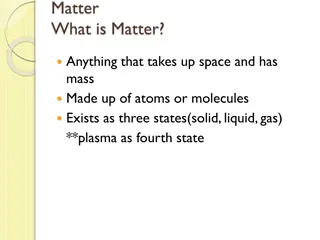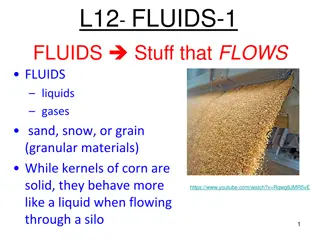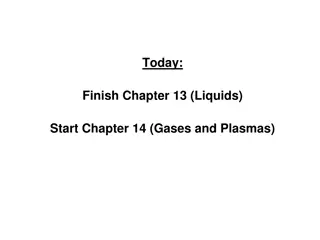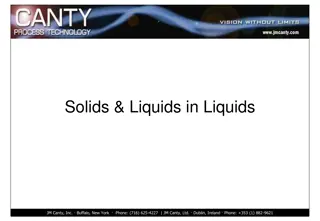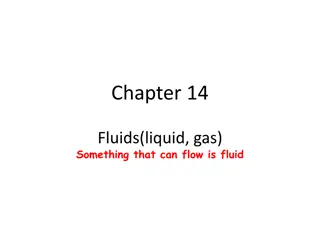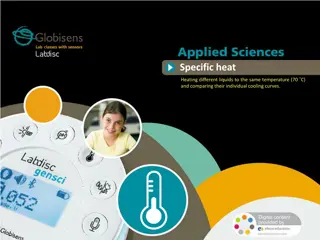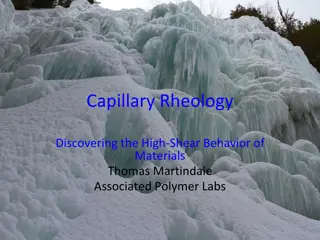Understanding Hydraulics and Pneumatics in Industrial Applications
This chapter explores the structure, advantages, and disadvantages of hydraulic and pneumatic systems utilized in industries for power transmission. Fluid power technology involving liquids or gases confined in systems like hydraulic (using liquid petroleum oils) and pneumatic (using compressed air)
1 views • 18 slides
Understanding Soil Phase Relationships and Properties
Soil consists of solids, liquids, and gases with voids in between. Water content, void ratio, porosity, specific gravity, mass specific gravity, degree of saturation, and unit weight are key parameters in characterizing soil behavior. Relationships between these properties are crucial for geotechnic
3 views • 8 slides
Understanding Earth's Interior through Seismic Waves: Part 1
Seismic waves provide crucial evidence about Earth's composition and structure. By analyzing the behavior of primary, secondary, and surface waves, scientists can determine the different layers and materials within the Earth. Primary waves travel through both solid and liquid parts, while secondary
10 views • 10 slides
Understanding the States of Matter: Solids, Liquids, and Gases
Matter is anything that occupies space and has mass, consisting of tiny particles like atoms and molecules. Solids have closely packed particles, liquids have less densely packed particles that can flow, and gases have spread out particles. Solids retain their shape, liquids take the shape of their
7 views • 11 slides
Understanding Filtration Process in Industrial Operations
Filtration, a crucial unit operation, involves separating solids from liquids by passing them through a porous medium. This process is essential in industries like oil refining, beer production, and fruit juice processing. Filtration can be categorized into cake filtration, clarification, and cross-
6 views • 31 slides
Understanding Properties of Gases and Gas Laws
Gases exhibit unique properties compared to solids and liquids, including compressibility and variable densities. Pressure is defined as force per unit area, with common pressure units like atm, mmHg, and torr. Gas laws such as Gay-Lussac's Law, Boyle's Law, and Charles's Law describe the relationsh
4 views • 33 slides
Understanding Syrups: Types, Formulations, and Storage Considerations
Syrups are sweet, viscous liquids used in pharmaceutical preparations. They can be non-medicated for flavoring or medicated for therapeutic purposes. There are sugar-based and sugar-free syrups, with sucrose preferred for its purity and handling ease. Preservatives like benzoate and sorbic acid are
4 views • 16 slides
Essential Factors Affecting Computers' Maintenance
Computers are susceptible to damage from various factors such as heat, dust, water, corrosive liquids, and powerline problems. To ensure optimal performance and longevity, it is crucial to monitor and address these elements to prevent potential harm. Proper maintenance practices like controlling hea
5 views • 14 slides
Screw classifier
CraftsmenCrusher's screw classifier is an innovative solution designed to efficiently separate and dewater solids from liquids.
1 views • 1 slides
Medicine Labels Manufacturer from Kolkata India
Medicine Labels offered comes in quality construction finish and in different shape and size so as to match up with the specific demands of the customers. With option of providing highly customized OEM solutions, these meet the packaging needs of product like tablet, teabag, medicinal granules, caps
0 views • 3 slides
Choosing The Right Immersion Heater Distributor For Business Success!
Immersion Heaters Distributors refers to businesses or individuals who specialize in the distribution of immersion heaters. Immersion heaters are electrical devices used to heat liquids such as water, oil, or chemicals by immersing them directly into the substance to be heated. Distributors of immer
1 views • 6 slides
Review of Critical Heat Flux in Liquid Hydrogen, Methane, and Oxygen
This review paper presents data and predictive tools on the critical heat flux (CHF) of liquid hydrogen, methane, and oxygen. It covers the motivation for CHF modeling, background on pool and flow boiling curves, availability of CHF data for different liquids, and applications in space propulsion sy
0 views • 15 slides
Understanding Fluid Mechanics: Archimedes, Pascal, and Bernoulli
Explore the principles of fluid mechanics including Archimedes' Principle, Pascal's Law, and Bernoulli's Principle. Learn about mass density, buoyant force, and the behavior of floating objects in liquids. Discover how the buoyant force is equal to the weight of displaced fluids, and how it affects
0 views • 22 slides
Investigating Different Liquids Evaporation Rates
This project aimed to determine if different liquids evaporate at the same rate. Through experiments with various liquids like tea, water, lemonade, Pepsi, and orange juice, it was observed that not all liquids evaporate at the same speed. The hypothesis that adding ingredients to water would slow d
0 views • 15 slides
Understanding Density and Pressure in Liquids
Exploring the concepts of density and pressure in liquids, this content covers topics such as the relationship between weight and density, examples of different material densities, and the effects of pressure on different surfaces. Understanding these principles can help grasp how matter behaves in
0 views • 33 slides
Understanding Thickened Liquids in Dysphagia Management
Thickened liquids are often recommended for residents with swallowing difficulties to prevent aspiration pneumonia. Recommendations are typically made by speech pathologists, with nursing sometimes adjusting based on availability of therapy. Aspiration pneumonia occurs when substances are inhaled in
2 views • 33 slides
Exploring Properties of Matter: Solids, Liquids, and Gases
Dive into the characteristics of solids, liquids, and gases through engaging visuals and key vocabulary. Understand the behavior of particles in different states of matter and learn about the properties that define each state. Explore examples of solids, liquids, and gases with a focus on their uniq
0 views • 19 slides
Understanding Properties of Liquids: Surface Tension & Capillary Action
Explore the properties of liquids, including surface tension and capillary action. Learn how liquids differ from solids and gases, the definition and measurement of surface tension, and the role of contact angle in capillary action.
0 views • 25 slides
Understanding Collenchyma and Sclerenchyma Tissues in Plants
Plant tissues play vital roles in providing structural support and protection. Collenchyma tissues are found in shoots and leaves, offering strength and flexibility, while sclerenchyma tissues provide rigid support in non-growing regions. Collenchyma cells have thickened corners for strength and pro
1 views • 8 slides
Electrical Breakdown in Gases, Solids, and Liquids: Understanding the Phenomenon
Exploring the intricate dynamics of electrical breakdown in various mediums such as gases, solids, and liquids. From the criteria for breakdown in gases to factors affecting breakdown strength in liquid dielectrics, this study delves into the mechanisms, equations, and practical implications of thes
0 views • 15 slides
Understanding Pressure in Liquids: Changes with Depth & Floating/Sinking
Learn about how liquid pressure changes with depth, why some objects float while others sink, and the effects of temperature on gas pressure. Explore the arrangements of particles in solids, liquids, and gases, and understand why dams have thick walls at the base. Enhance your knowledge of internal
6 views • 14 slides
Introduction to Properties of Fluids in Hydraulic Systems
Fluids, including liquids and gases, exhibit continuous deformation when subjected to shear forces. Understanding fundamental properties like density, specific weight, and specific volume is crucial for applying fluid mechanics principles to solve practical problems in fluid power systems. This chap
0 views • 34 slides
Design Considerations for Storage Tanks
Storage tanks play a crucial role in various industries for holding liquids or gases, such as raw materials, intermediate products, fuels, and off-grade materials. Different types of storage tanks are available, including vertical and horizontal cylindrical tanks with various bottom shapes. The choi
0 views • 28 slides
Overview of U.S. Petroleum and Natural Gas Production Trends
This detailed content discusses the production and consumption of crude oil, natural gas plant liquids, and petroleum liquids in the United States. It covers historical data, projections, economic growth scenarios, and price cases for the period up to 2050. The information sheds light on production
0 views • 18 slides
Nutritional Guidance for Children with Health Challenges
This presentation by Maria Raspolic, MS, RD discusses common nutritional issues in children with health challenges, providing recommendations to address these issues and exploring the use of the ketogenic diet for seizure management. Topics cover poor growth, dehydration, constipation, inadequate nu
0 views • 29 slides
Understanding Thermal Expansion in Solids and Liquids
Explore the effects of thermal energy on solids and liquids, learning how they expand when heated and contract when cooled. Discover the molecular explanation behind thermal expansion and observe real-world examples of expansion and contraction in everyday life. Gain insights into the unique expansi
0 views • 23 slides
Understanding Mixtures of Materials in Grade 6 Natural Sciences and Technology
Exploring mixtures of materials in Grade 6 Natural Sciences and Technology, students learn about what mixtures are, examples of mixtures including solids and liquids, mixing solids, separating substances, and mixing liquids. The content also discusses the visibility of different substances in mixtur
0 views • 8 slides
Understanding the States of Matter: Solids, Liquids, and Gases
Matter encompasses everything that occupies space and has mass. It exists in three states - solid, liquid, and gas - distinguished by the arrangement and behavior of particles. Solids have fixed shapes, liquids take the shape of their container, and gases fill any container. Each state has unique pr
0 views • 14 slides
Effect of pH Levels on Sponge Performance Experiment
This experiment explores the impact of different pH levels on a sponge's ability to absorb liquids. By testing sponges soaked in liquids with varying pH levels such as water, orange juice, and green tea, the study aims to evaluate how pH affects sponge absorbency. The hypothesis suggests that sponge
0 views • 10 slides
Insights into Quasiparticles in Normal and Superfluid Fermi Liquids
This content discusses quasiparticles in normal and superfluid Fermi liquids, covering topics such as the Landau Fermi-liquid idea, BCS theory, Bogoliubov-de Gennes approach, Majorana fermions, conservation quantities in liquids, consequences of conservation for response functions, and applications
0 views • 23 slides
Understanding Thickened Fluids in Aged Care Facilities
Exploring the adequacy of thickened fluids in residential aged care settings, a study examined staff perceptions, preparation factors, adherence to IDDSI standards, and issues related to dysphagia. Findings revealed barriers, enablers, and the importance of staff education and support in ensuring th
0 views • 7 slides
Understanding Boiling and Evaporation of Liquids
Learn about the process of boiling and evaporation of liquids, including how liquids transform into gases, the role of temperature in these changes, examples of evaporation in daily life, and fun experiments to explore drying times. Discover the three states of matter and the significance of water v
0 views • 10 slides
Understanding States of Matter and Kinetic Theory
Matter is anything that occupies space and has mass, existing in solid, liquid, gas, and plasma states. The states of matter depend on the arrangement and motion of atoms. Solids have fixed shapes, liquids take the shape of their container, and gases fill the volume of their container. The Kinetic T
0 views • 18 slides
Understanding Intermolecular Forces and Dispersion Forces in Molecules
Particle diagrams of liquids, solids, and gases reflect distinct arrangements due to intermolecular forces. The existence of substances as gases, liquids, or solids at room temperature is attributed to the forces between molecules known as intermolecular forces (IMF), with dispersion forces being th
0 views • 30 slides
Understanding Matter: Solids, Liquids, Gases, and Fluids
Matter exists in various states - solid, liquid, gas, and fluid. Solids have atoms closely packed, liquids have more freedom but still cohesion, gases have atoms spread out, and fluids flow like liquids or gases. Mass density characterizes matter based on atom proximity. Gas pressure results from mo
0 views • 22 slides
Exploring the Fascinating World of Gases and Plasmas in Chapter 14
Delve into the intriguing realm of gases and plasmas as we transition from liquids in Chapter 13. Understand the dynamics of fluid pressure, buoyancy, and the unique characteristics that differentiate gases from liquids. Explore examples illustrating the concepts and ponder over the mysteries of our
0 views • 28 slides
Vision-Based Particle Analysis Techniques for Solids and Liquids Measurement
Solids and Liquids in Liquids and Solids in Liquid Measurement are performed by JM Canty, Inc. Their innovative vision-based particle analysis techniques involve dynamic imaging with high-intensity light sources and cameras to measure particle size, shape, and concentration in various liquid systems
0 views • 22 slides
Understanding Fluids: Density, Specific Gravity, and Pressure in Liquids and Gases
Fluids such as liquids and gases possess properties like density, specific gravity, and pressure that play a crucial role in their behavior. Density measures the heaviness of a material, while specific gravity compares the mass of a material to that of water. Pressure affects the density of fluids,
0 views • 55 slides
Comparing Cooling Curves of Different Liquids at 70°C
The activity involves heating different liquids to the same temperature (70°C) and comparing their individual cooling curves to understand their specific heat capacities. Students create hypotheses about the heat release during cooling, test them using temperature sensors, and explore how molecular
0 views • 23 slides
Understanding Capillary Rheology: A Guide to High-Shear Behavior
Capillary rheology is a study of materials that flow, combining properties of liquids and solids. By passing liquids through small tubes, capillary rheology allows for the analysis of high-shear behavior, crucial for processes like extrusion and coating. Learn about the basic terms, anatomy of a cap
0 views • 29 slides
